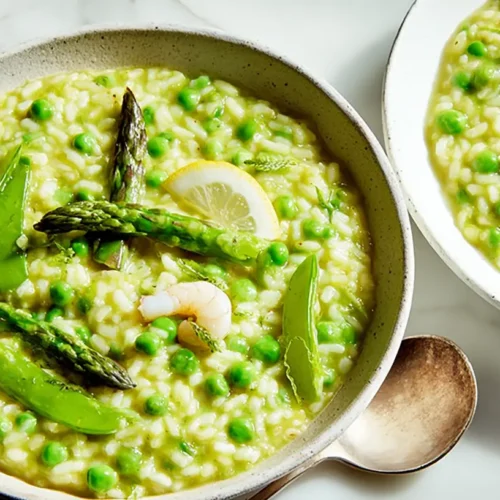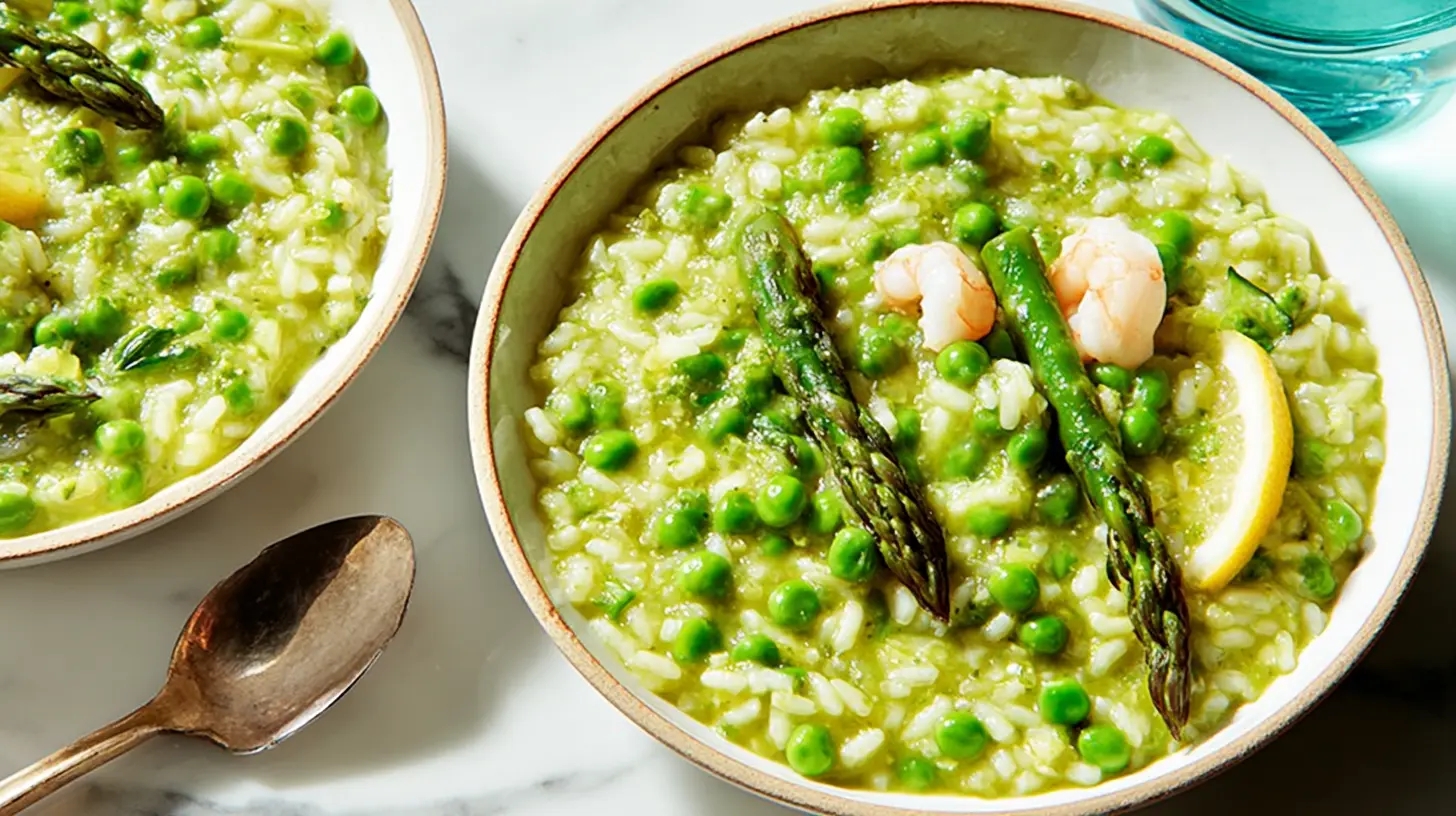For me, spring signals a kitchen reawakening. After months of hearty stews and comforting roasts, I find myself yearning for something fresh yet still deeply satisfying. That’s precisely where this Spring Risotto steps in. It’s that perfect bridge meal, bringing together the creamy richness we crave from a good risotto with the vibrant, zesty flavors of the season’s first offerings. Every time I make it, it feels like I’m celebrating the arrival of warmer days, one delicious, Arborio-filled spoonful at a time. It’s truly a dish that brightens both your plate and your mood.
Why You’ll Love This Dish
There’s something inherently magical about risotto, and this spring rendition takes that magic a step further. What makes this recipe so special is its ability to deliver incredible depth of flavor using fresh, simple ingredients. It’s not just a meal; it’s an experience. You get the luxurious, velvety texture that only a perfectly cooked risotto can offer, beautifully complemented by the bright, tender crunch of spring vegetables. It’s substantial enough for a satisfying weeknight dinner but also elegant enough to impress guests at a relaxed weekend gathering. Plus, it’s a fantastic way to celebrate the bounty of spring produce, making the most of those fleeting seasonal delights.
> “I thought making risotto was complicated, but this recipe made it so approachable! The flavors were incredible, and it felt like a gourmet meal without all the fuss. Definitely a new family favorite!” — A recent home cook.
The Cooking Process Explained
Making this Spring Risotto might seem intimidating if you’ve never tackled risotto before, but I promise it’s more about rhythm and attention than complex techniques. At its heart, you’ll be slowly coaxing starches out of Arborio rice by gradually adding warm broth, stirring almost constantly but never rigorously. This patient process creates that signature creamy texture without adding actual cream. We’ll toast the rice lightly first to lock in flavor, then deglaze with a splash of wine, and finally, fold in those gorgeous spring vegetables right at the end to ensure they’re perfectly tender-crisp, not mushy. A final flourish of butter and Parmesan pulls it all together into a harmonious, comforting dish.
What You’ll Need
To bring this vibrant Spring Risotto to life, gather these essential items:
- 2 tablespoons olive oil
- 1 small yellow onion, finely chopped
- 2 cloves garlic, minced
- 1 ½ cups Arborio rice
- ½ cup dry white wine (such as Sauvignon Blanc or Pinot Grigio)
- 6-7 cups hot vegetable broth (or chicken broth)
- 1 cup asparagus, woody ends trimmed and cut into 1-inch pieces
- 1 cup frozen peas, thawed
- ½ cup fresh spinach, roughly chopped
- ¼ cup grated Parmesan cheese, plus more for serving
- 2 tablespoons unsalted butter
- 2 tablespoons fresh lemon juice
- Salt and freshly ground black pepper to taste
- Fresh parsley or chives, chopped, for garnish (optional)
Directions to Follow
Here’s how to create your perfect Spring Risotto:
- Prep Your Broth: In a medium saucepan, gently heat the vegetable broth and keep it at a bare simmer over low heat. It’s crucial to add hot broth to the rice to maintain cooking temperature.
- Sauté Aromatics: In a large, heavy-bottomed pot or Dutch oven, heat the olive oil over medium heat. Add the chopped onion and cook until softened and translucent, about 5-7 minutes. Stir in the minced garlic and cook for another minute until fragrant, being careful not to let it brown.
- Toast the Rice: Add the Arborio rice to the pot with the onions and garlic. Stir continuously for 2-3 minutes, toasting the grains until they appear slightly translucent around the edges but still firm in the center. This step is important for flavor and texture.
- Deglaze with Wine: Pour in the white wine. Stir constantly until the wine is completely absorbed by the rice. The alcohol will evaporate, leaving behind a lovely depth of flavor.
- Add Broth Gradually: Begin adding the hot broth, one ladleful at a time (about ½ cup). Stir frequently, allowing each addition of broth to be almost completely absorbed by the rice before adding the next. This gentle stirring helps release the starch from the rice, creating that creamy texture. Continue this process for about 15-20 minutes.
- Incorporate Spring Veggies: When you have about 1 ½ cups of broth remaining, stir in the asparagus pieces. Continue adding broth and stirring. With the last ladleful of broth, add the thawed peas and chopped spinach. Continue stirring until the risotto is creamy and the rice is al dente – tender but with a slight bite in the center. This should take another 5-7 minutes.
- Finish and Season: Remove the pot from the heat. Stir in the Parmesan cheese, butter, and fresh lemon juice. Season with salt and freshly ground black pepper to taste. The risotto should be luscious and slightly fluid (known as all’onda, or “wavy”). If it’s too thick, add a splash more hot broth.
- Serve Immediately: Ladle the risotto into warm bowls. Garnish with additional Parmesan cheese, fresh parsley, or chives, if desired.
What to Serve It With
This Spring Risotto is a complete meal in itself, but if you’re looking to round out your dining experience, a light, crisp side can be wonderful. I often enjoy it with a simple green salad dressed with a bright vinaigrette – something like mixed greens with sliced radishes or snap peas to complement the freshness. A basket of crusty bread is always a welcome accompaniment to sop up any delicious remnants. For drinks, the same dry white wine you used in the recipe, or even a sparkling rosé, would pair beautifully with the vibrant flavors.
Keeping Leftovers Fresh
Risotto is best enjoyed fresh from the pot, as its creamy texture can change upon cooling. However, if you do have leftovers, they can be stored in an airtight container in the refrigerator for up to 2-3 days.
Reheating: To reheat, gently warm the risotto in a saucepan over low heat, adding a splash of extra vegetable broth or water to help revive its creaminess and prevent it from drying out. Stir constantly until heated through. Microwaving is an option, but be warned, it can make the rice a bit sticky; a splash of broth can still help.
Freezing: I generally don’t recommend freezing risotto. The texture of the rice can become quite mushy and less pleasant after thawing and reheating. It’s best to enjoy this dish within a few days!
Pro Chef Tips
Want to take your Spring Risotto from great to outstanding? Here are a few tricks I’ve learned along the way:
- Prep is King: Have all your ingredients (especially the hot broth!) ready and within arm’s reach before you start cooking. Risotto moves quickly once you begin adding broth, and you don’t want to be scrambling.
- Don’t Overcook the Veggies: Add delicate spring vegetables like asparagus, peas, and spinach towards the end of cooking. This keeps them vibrant, slightly crisp, and full of flavor. Mushy vegetables are a no-go!
- Stir, Don’t Stop (Mostly): While constant stirring helps release starches, it doesn’t have to be every single second. A good, frequent stir is what you’re after. The main goal is to prevent the rice from sticking to the bottom of the pot.
- Taste, Taste, Taste: Season along the way. The broth can be salty, and adding Parmesan cheese will add more salt. Taste your risotto before adding the final seasoning adjustments at the end.
- Embrace the Al Dente: The perfect risotto rice should be tender but still have a slight, pleasant chew in the center. Avoid overcooking it to a mushy state.
Creative Twists
This Spring Risotto is a fantastic canvas for various flavor explorations. Here are a few ideas to get your creative juices flowing:
- Herbaceous Boost: Beyond parsley or chives, consider stirring in fresh dill, tarragon, or a touch of mint at the end for an extra layer of springtime flavor.
- Say Cheese!: While Parmesan is classic, try finishing with a different cheese like crumbled goat cheese for a tangy kick, or some Pecorino Romano for a sharper, saltier note.
- Protein Power-Up: For a heartier meal, you could stir in cooked shrimp, flaked salmon, or even some grilled chicken breast during the last few minutes of cooking. Sautéed mushrooms would also be a lovely addition.
- Lemon Zest Explosion: For even more brightness, add a teaspoon of fresh lemon zest along with the lemon juice at the end.
- Nutty Crunch: A sprinkle of toasted pine nuts or slivered almonds just before serving can add a delightful textural contrast.
Common Questions
Can I make this Spring Risotto vegetarian/vegan?
A: Yes, absolutely! This recipe is already vegetarian if you use vegetable broth. To make it vegan, omit the Parmesan cheese and butter, and finish it with a drizzle of good quality olive oil or a plant-based butter alternative. Nutritional yeast can also be added for a cheesy flavor.
What if I don’t have white wine? Can I skip it?
A: While white wine adds a wonderful layer of acidity and depth, you can substitute it with an equal amount of extra vegetable broth, or even a splash of white grape juice with a tiny bit of red wine vinegar for a similar acidic profile.
My risotto isn’t as creamy as I’d like. What did I do wrong?
A: Creaminess comes from a few factors: using Arborio rice (which is high in starch), constant stirring to release that starch, and gradually adding hot broth. If it’s not creamy, you might not have stirred enough, or your broth wasn’t hot enough. Don’t worry, a bit more stirring and a final swirl of butter and Parmesan usually helps! Ensure you’re not cooking the rice too quickly on high heat, which might evaporate liquid before starches properly release.

Vibrant Spring Risotto with Asparagus and Peas
Equipment
- Large, heavy-bottomed pot or Dutch oven
- Ladle
Ingredients
Main Ingredients
- 1 tablespoon olive oil
- 1 small shallot
- 2 cloves garlic
- 1 cup Arborio rice
- 1/2 cup dry white wine
- 4-5 cups hot vegetable broth
- 1 cup asparagus
- 1 cup fresh or frozen green peas
- 1/4 cup grated Parmesan cheese
- 2 tablespoons unsalted butter
- 2 tablespoons fresh parsley
- to taste Salt and freshly ground black pepper
Garnish (Optional)
- lemon zest
- serving extra fresh herbs
Instructions
Preparation
- Heat olive oil in a large pot over medium heat, then add shallots and cook until softened for 3-4 minutes.
- Stir in minced garlic for one minute until fragrant, then add Arborio rice and toast for 2 minutes, stirring constantly.
- Pour in white wine and stir until fully absorbed by the rice.
Cooking
- Gradually add hot vegetable broth, one ladleful at a time, stirring continuously until each addition is almost completely absorbed.
- Continue this process for 15-20 minutes to develop a creamy texture.
Finishing Touches
- When the risotto is almost al dente, stir in asparagus and peas, and continue adding broth until vegetables are tender-crisp and risotto is creamy.
- Remove from heat, stir in Parmesan cheese and butter until incorporated, then season with salt, pepper, and fresh parsley.

